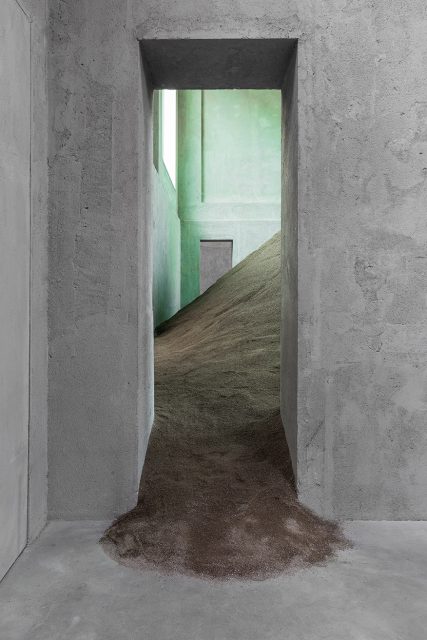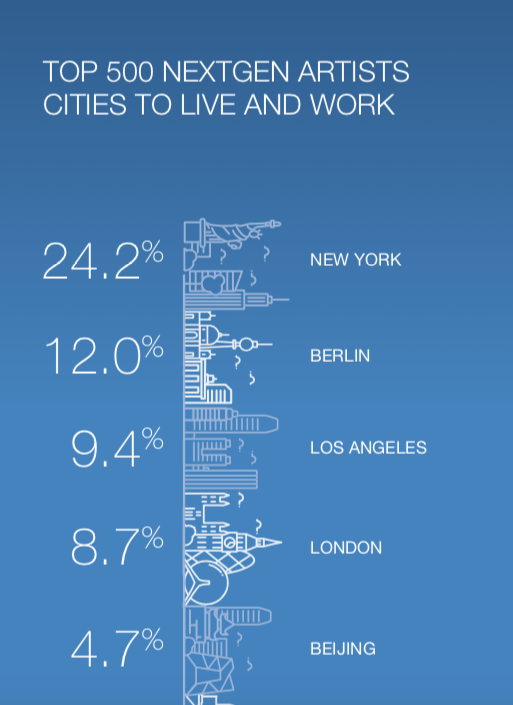Draped Concrete (detail) by Argentinian artist Analia Saban (1981). Saban is included in the NextGen Top 100 artists under 40. She lives and works in Los Angeles. Image provided for the NextGen report courtesy of the artist and Spruth Magers.
“It has been fascinating to analyse the migration patterns, the education data, the role of younger galleries in supporting new talents and how the auction market creates gender imbalances from the outset of the artist’s career.” – Anders Petterson, CEO of ArtTactic
Which young artist, walking among us, is destined to become the next Picasso? It’s a question asked by gallerists, curators, museums, and scholars worldwide: Which contemporary artists’ works will our great-grandchildren be inspecting on their school trip to MoMa?
The contemporary art enthusiasts among us recognise that forecasting the next generation of big artists requires a comprehensive understanding of the current contemporary art scene. Success for an emerging artist can come in many different forms, from institutional validation from major museums to commercial success in top galleries or art fairs. And with the recent explosion of the contemporary art market in the last 15 years – with annual turnovers for Sotheby’s and Christie’s jumping from a pre-millennium $270 million to last year’s $3.3 billion – an increasing number of individuals are extremely interested in the next generation of rising stars. Due to this great demand, ArtTactic and JLT Insurance have combined their decades of experience in the contemporary art market to identify the top 500 most successful contemporary artists working today.
The inaugural NextGen Artists’ Report is the very first of its kind, providing the first comprehensive analysis of the careers of the most successful contemporary artists under the age of 40. The NextGen Report applies a strict set of institutional and commercial criteria – filtering artists by their inclusion in a number of top prestigious museums, biennials, arts prizes, galleries, art fairs, and auctions – and then analyses information about these artists’ careers in order to reveal larger trends within this elite group. David Gordon, CEO of Fine Art, Jewelry, and Specie, at JLT comments, “From education and country of residence, to art prizes and the importance of international art fairs, this report aims to explore the variety of influences to which an artist is exposed during their career in the current contemporary art market.”

The Top 100 list includes some familiar faces, such as Alex Israel, Jordan Wolfson, Njideka Akunyili Crosby, and Alicja Kwade. However, readers may be less familiar with the quirky and colourful multi-media work of 32-year-old Korakrit Arunanondchai from Thailand, or the impressive installations by Mexican artist Pia Camil. Two talented women from the Top 100 list have individual features in the report: Argentinian artist Analia Saban and Swiss artist Pamela Rosenkrantz. Both artists have a diverse practice and work across multiple mediums, from sculpture, printmaking and photography in Saban’s case, to installation, sculpture, and video and performance for Rosenkrantz. Both features highlight the promising careers of two under 40 female artists using unconventional materials to push the boundaries of their practice.
While the US and Europe have a very strong showing in the Top 100, the list is quite diverse, featuring artists that hail from all regions of the world: Africa, the Middle East, Asia, Latin America, and Oceania. That is not to say that artists often live and work in their country of origin; in fact, the opposite is true. The NextGen report found that while artists originate from many diverse countries and cultures, 40% of the Top 500 artists move abroad to begin their career. The majority of these artists move to New York, followed by Berlin, Los Angeles, London, and then Beijing.

The idea that artists from all over the world flock to major cities of culture in the US and EU to start their career is not revolutionary. However, tracking these artists’ journeys across the globe reveals settlement patterns based on an artist’s country of origin. While the majority of European and American artists remain in the EU and the US respectively, the majority of Middle Eastern artists tend to migrate to the US, while African artists choose to move to Europe. The report also reveals that education is the most important factor in an artist’s decision to establish their career abroad, with 72% of the top 500 artists under 40 living and working in the country of their final degree. Therefore, when choosing a city in which to study, young artists should be asking themselves not only, “Where do I want to study?”, but ultimately: “Where do I want to establish my career?”.

Overall, the data presented in the report is significant in its depth, but also its breadth. Information regarding gender, education, nationality, gallery representation, auction history, and social media activity, etc is analysed to reveal both fascinating trends and surprising biases. Anders Petterson, CEO of ArtTactic, comments of the unprecedented scope of the study: “This is the first time anyone has attempted to map out the different journeys that younger artists embark on when trying to build a professional and sustainable career as an artist. It has been fascinating to analyse the migration patterns, the education data, the role of younger galleries in supporting new talents and how the auction market creates gender imbalances from the outset of the artist’s career.”
The data surrounding the gender gap in the contemporary art world was perhaps the most shocking. While women artists are reaching the upper echelons of the contemporary art world, their reach only extends so far. In the list of the Top 500 NextGen artists, 46% are female and 54% are male. However, the gap widens significantly in the Top 100, where only 39% of artists are female. Finally, when it comes to artists with a significant presence in the auction market (more than 25 lots sold at auction in their career so far), the gap becomes ridiculously large, with only 15% women and 85% men.
This is particularly surprising in light of the report’s findings about education. Within the Top 500 artists, women tend to study for higher degrees (MA and PhD), with 53% of women earning an MA degree, and 64% of women earning a PhD. Meanwhile, significantly more male artists end their studies with a Bachelor degree.
These statistics raise important questions about how institutional support is distributed in the contemporary art sphere: Why doesn’t a higher level of education result in more success for female artists? If women are receiving enough institutional support to break into the Top 500, why is it not enough to boost them to the Top 100? Is there a limit to the amount of success a female artist is afforded by arts institutions, both cultural and commercial? Finally, if museums and galleries are, to a certain extent, supporting the representation of female artists in contemporary art, then why aren’t auction houses? And while the NextGen report cannot begin to answer these important questions regarding the gender gap in the art world, the statistics presented in the report are what motivate us to ask them in the first place.
Access ArtTactic and JLT’s inaugural NextGen Report here.

